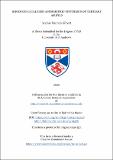Files in this item
Rhodium catalysed asymmetric synthesis of tertiary amines
Item metadata
| dc.contributor.advisor | Clarke, Matt | |
| dc.contributor.author | Gilbert, Sophie Hannah | |
| dc.coverage.spatial | x, 324 p. | en_US |
| dc.date.accessioned | 2020-02-25T14:17:35Z | |
| dc.date.available | 2020-02-25T14:17:35Z | |
| dc.date.issued | 2020-06-24 | |
| dc.identifier.uri | https://hdl.handle.net/10023/19528 | |
| dc.description.abstract | The asymmetric synthesis of tertiary amines is a highly desirable goal, but far fewer efficient synthetic methods exist for their synthesis, relative to primary and secondary amines. A possible atom-efficient method of tertiary amine formation is catalytic hydrogenation. Despite the demand, there are only a few reported examples of asymmetric enamine hydrogenation, and none of these conditions are efficient enough to be viable for industrial processes. Until 2019, there were no reported examples of tertiary amine formation by using direct asymmetric reductive amination using H₂ as the reductant. This thesis describes the development of both enantioselective and diastereoselective reductive aminations, using hydrogen gas and homogeneous rhodium catalysts. The enantioselective reductive amination uses an electron deficient phanephos ligand and reduces bicyclic aryl ketones at low catalyst loadings but moderate selectivity. The diastereoselective reductive amination uses electron deficient monophosphines as ligands and includes many chiral 3-substituted cyclic ketones in the substrate scope, mainly 3- arylcyclohexanones. These 3-arylcyclohexanones substrates were synthesised by rhodium catalysed conjugate addition. This enantioselective conjugate addition was combined with our diastereoselective reductive amination, to form a highly stereoselective one-pot process. The rhodium used in the conjugate addition was recycled for the reductive amination step using an ‘assisted tandem catalysis’ strategy. The rhodium catalyst was modified in situ by the sequential addition of a monophosphine ligand, allowing it to catalyse the second step. This process formed a chiral tertiary amine with high selectivity and conversion. While developing this one-pot process, BOBPHOS, a phospholane-phosphite ligand, was identified as a highly active ligand in rhodium catalysed conjugate additions. The potential of BOBPHOS-Rh catalysed conjugate additions of challenging substrates like piperidones, coumarins and heteroarylboronic acids was examined, leading to improved protocols. | en_US |
| dc.description.sponsorship | "This work was supported by the Engineering and Physical Sciences Research Council and EPSRC Centre for Doctoral Training in Critical Resource Catalysis [Grant code: EP/L016419/1]." -- Acknowledgements | en |
| dc.language.iso | en | en_US |
| dc.publisher | University of St Andrews | |
| dc.relation | Rhodium catalysed asymmetric synthesis of tertiary amines (Thesis data) Gilbert, S.H., University of St Andrews. DOI: https://doi.org/10.17630/f3ca109d-6925-43a2-9745-13fcdae174f8 | en |
| dc.relation.uri | https://doi.org/10.17630/f3ca109d-6925-43a2-9745-13fcdae174f8 | |
| dc.rights | Creative Commons Attribution-NonCommercial-NoDerivatives 4.0 International | * |
| dc.rights.uri | http://creativecommons.org/licenses/by-nc-nd/4.0/ | * |
| dc.subject | Chemistry | en_US |
| dc.subject | Catalysis | en_US |
| dc.subject | Homogeneous catalysis | en_US |
| dc.subject | Hydrogenation | en_US |
| dc.subject | Asymmetric catalysis | en_US |
| dc.subject | Chiral amines | en_US |
| dc.subject | Organometallic chemistry | en_US |
| dc.subject.lcc | QD505.G5 | |
| dc.subject.lcsh | Rhodium catalysts | en |
| dc.subject.lcsh | Asymmetric synthesis | en |
| dc.subject.lcsh | Hydrogenation | en |
| dc.subject.lcsh | Catalysis | en |
| dc.subject.lcsh | Organometallic chemistry | en |
| dc.title | Rhodium catalysed asymmetric synthesis of tertiary amines | en_US |
| dc.type | Thesis | en_US |
| dc.contributor.sponsor | Engineering and Physical Sciences Research Council (EPSRC) | en_US |
| dc.contributor.sponsor | Critical Resource Catalysis Centre for Doctoral Training (CRITICAT) | en_US |
| dc.type.qualificationlevel | Doctoral | en_US |
| dc.type.qualificationname | PhD Doctor of Philosophy | en_US |
| dc.publisher.institution | The University of St Andrews | en_US |
| dc.identifier.doi | https://doi.org/10.17630/10023-19528 |
The following licence files are associated with this item:
This item appears in the following Collection(s)
Except where otherwise noted within the work, this item's licence for re-use is described as Creative Commons Attribution-NonCommercial-NoDerivatives 4.0 International
Items in the St Andrews Research Repository are protected by copyright, with all rights reserved, unless otherwise indicated.


